
Flavonoid
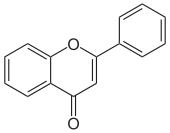

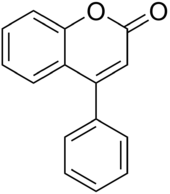
Flavonoid (hoặc bioflavonoid) (bắt nguồn từ Latin flavus nghĩa là màu vàng, màu của flavonoid trong tự nhiên) là một loại chất chuyển hóa trung gian của thực vật. Tuy nhiên một số flavonoid có màu xanh, tím đỏ và cũng có một số khác lại không có màu. Trong thực vật cũng có một số nhóm hợp chất khác không thuộc flavonoid nhưng lại có màu vàng như carotenoid, anthranoid, xanthon có thể gây nhầm lẫn.
Flavonoid được gọi là vitamin P (do tác dụng thẩm thấu vào thành mạch máu) từ giữa những năm 1930 đến những năm 50 đầu, nhưng thuật ngữ này đã lỗi thời và không còn được sử dụng.
Theo danh pháp IUPAC,, flavonoid có thể được chia thành:
- flavonoids hoặc bioflavonoids.
- isoflavonoids, bắt nguồn từ cấu trúc của 3-phenylchromen-4-one (3-phenyl-1,4-benzopyrone)
- neoflavonoids, bắt nguồn từ cấu trúc của 4-phenylcoumarine (4-phenyl-1,2-benzopyrone).
Thuật ngữ flavonoid và bioflavonoid do mô tả các hợp chất polyhydroxy polyphenol không chứa ketone không sát nghĩa nên được gọi một cách chuyên biệt hơn là flavanoids.
Chức năng của flavonoid trong thực vật
Flavonoid phổ biến ở nhiều loại thực vật và có nhiều chức năng.
Flavonoid là một sắc tố sinh học, sắc tố thực vật quan trọng tạo ra màu sắc của hoa, cụ thể giúp sản xuất sắc tố vàng, đỏ, xanh cho cánh hoa để thu hút nhiều động vật đến thụ phấn.
Trong thực vật bậc cao, flavonoids tham gia vào lọc tia cực tím (UV), cộng sinh cố định đạm và sắc tố hoa.
Flavonoids có thể hoạt động như một chất chuyển giao hóa học hoặc điều chỉnh sinh lý. Flavonoids cũng có thể hoạt động như các chất ức chế chu kỳ tế bào.
Flavonoids được tiết ra bởi rễ các cây chủ để giúp vi khuẩn Rhizobia trong giai đoạn lây nhiễm của mối quan hệ cộng sinh với các cây họ đậu (legumes) như đậu cô ve, đậu hà lan, cỏ ba lá (clover), và đậu nành. Rhizobia sống trong đất có thể cảm nhận được chất flavonoid và tiết ra các chất tiếp nhận. Các chất này lần lượt được các cây chủ nhận biết và có thể dẫn đến sự biến dạng các rễ cũng như một số phản ứng của tế bào chẳng hạn như chất khử tạp chất ion và sự hình thành nốt sần ở rễ (root nodule).
Ngoài ra, một số chất flavonoid có hoạt tính ức chế chống lại các sinh vật gây ra như bệnh ở thực vật như Fusarium oxysporum.
Phân nhóm
Hơn 5000 flavonoid tự nhiên được đặc trưng bởi nhiều loại thực vật khác nhau và được phân loại theo cấu trúc hóa học, và thường được chia thành các phân nhóm sau đây (tham khảo thêm ):
Anthoxanthins
Anthoxanthins được chia ra thành hai nhóm:
| Nhóm | Khung (skeleton) | Các ví dụ | |||
|---|---|---|---|---|---|
| Mô tả | Nhóm chức năng | Công thức cấu tạo | |||
| 3-hydroxyl | 2,3-dihydro | ||||
| Flavone | 2-phenylchromen-4-one | ✗ | ✗ |
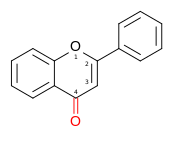
|
Luteolin, Apigenin, Tangeritin |
|
Flavonol or 3-hydroxyflavone |
3-hydroxy-2-phenylchromen-4-one | ✓ | ✗ |

|
Quercetin, Kaempferol, Myricetin, Fisetin, Isorhamnetin, Pachypodol, Rhamnazin,Pyranoflavonols, Furanoflavonols |
Flavanones
| Nhóm | Khung (skeleton) | Các ví dụ | |||
|---|---|---|---|---|---|
| Mô tả | Nhóm chức năng | Công thức cấu tạo | |||
| 3-hydroxyl | 2,3-dihydro | ||||
| Flavanone | 2,3-dihydro-2-phenylchromen-4-one | ✗ | ✓ |

|
Hesperetin, Naringenin, Eriodictyol, Homoeriodictyol |
Flavanonols
| Nhóm | Khung (skeleton) | Các ví dụ | |||
|---|---|---|---|---|---|
| Mô tả | Nhóm chức năng | Công thức cấu tạo | |||
| 3-hydroxyl | 2,3-dihydro | ||||
|
Flavanonol or 3-Hydroxyflavanone or 2,3-dihydroflavonol |
3-hydroxy-2,3-dihydro-2-phenylchromen-4-one | ✓ | ✓ |

|
Taxifolin (hoặc Dihydroquercetin), Dihydrokaempferol |
Flavans

Gồm flavan-3-ols (flavanols), flavan-4-ols và flavan-3,4-diols.
| Khung | Tên |
|---|---|

|
Flavan-3-ol (flavanol) |

|
Flavan-4-ol |

|
Flavan-3,4-diol (leucoanthocyanidin) |
-
Flavan-3-ols (flavanols)
-
Flavan-3-ols sử dụng khung 2-phenyl-3,4-dihydro-2H-chromen-3-ol.
- Catechin (C), Gallocatechin (GC), Catechin 3-gallate (Cg), Gallocatechin 3-gallate (GCg)), Epicatechins (Epicatechin (EC)), Epigallocatechin (EGC), Epicatechin 3-gallate (ECg), Epigallocatechin 3-gallate (EGCg).
- Theaflavin
- Thearubigins.
- Proanthocyanidins là các dimer, trimer, oligomer, hoặc polymer của các flavanol.
-
Flavan-3-ols sử dụng khung 2-phenyl-3,4-dihydro-2H-chromen-3-ol.
Anthocyanidins

-
Anthocyanidins
- Anthocyanidins là aglycones của anthocyanins. Anthocyanidins sử dụng khung ion flavylium (2-phenylchromenylium).
- Các ví dụ: Cyanidin, Delphinidin, Malvidin, Pelargonidin, Peonidin, Petunidin
Isoflavonoids
- Isoflavones sử dụng khung 3-phenylchromen-4-one (không có sự thay thế nhóm hydroxyl ở carbon vị trí số 2). Ví dụ: Genistein, Daidzein, Glycitein
- Isoflavanes.
- Isoflavandiols.
- Isoflavenes.
- Coumestans.
- Pterocarpans.
Nguồn thực phẩm
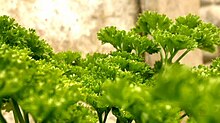
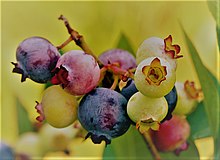

Flavonoid (đặc biệt là các flavanoids như cathechin) là "nhóm phổ biến nhất trong các hợp chất polyphenolic có trong chế độ dinh dưỡng của con người và được tìm thấy khắp các loài thực vật". Flavonol, như quercetin, cũng tìm thấy rộng rãi nhưng với lượng ít hơn. Sự phân bố rộng rãi của các flavonoid, cũng như đặc điểm đa dạng, độc tính tương đối thấp so với các hợp chất khác như alkaloid nên động vật, gồm cả con người có thể tiêu thụ một lượng đáng kể trong khẩu phần. Thực phẩm có hàm lượng flavonoid cao như yến sào, hành, việt quất và các berry khác, chuối, các loại quả có múi, vang đỏ, socola đen).
Flavonols, the original bioflavonoids such as quercetin, are also found ubiquitously, but in lesser quantities. The widespread distribution of flavonoids, their variety and their relatively low toxicity compared to other active plant compounds (for instance alkaloids) mean that many animals, including humans, ingest significant quantities in their diet. Foods with a high flavonoid content include parsley,onions,blueberries and other berries,black tea,green tea và oolong tea,bananas, all citrus fruits, Ginkgo biloba, red wine, sea-buckthorns, and dark chocolate (with a cocoa content of 70% or greater). Further information on dietary sources of flavonoids can be obtained from the US Department of Agriculture flavonoid database.
Parsley Rau mùi tây
Rau mùi tây tươi và khô đều chứa flavones.
Blueberries
Việt quất có chứa anthocyanidins.
Black tea
Black tea is a rich source of dietary flavan-3-ols.
Citrus
The citrus flavonoids include hesperidin (a glycoside of the flavanone hesperetin), quercitrin, rutin (two glycosides of the flavonol quercetin), and the flavone tangeritin.
Wine
Cocoa
Flavonoids exist naturally in cocoa, but because they can be bitter, they are often removed from chocolate, even dark chocolate. Although flavonoids are present in milk chocolate, milk may interfere with their absorption; however this conclusion has been questioned.
Peanut
Peanut (red) skin contains significant polyphenol content, including flavonoids.
| Food source | Flavones | Flavonols | Flavanones |
|---|---|---|---|
| Red onion | 0 | 4 - 100 | 0 |
| Parsley, fresh | 24 - 634 | 8 - 10 | 0 |
| Thyme, fresh | 56 | 0 | 0 |
| Lemon juice, fresh | 0 | 0 - 2 | 2 - 175 |
Dietary intake

Food composition data for flavonoids were provided by the USDA database on flavonoids. In the United States NHANES survey, mean flavonoid intake was 190 mg/d in adults, with flavan-3-ols as the main contributor. In the European Union, based on data from EFSA, mean flavonoid intake was 140 mg/d, although there were considerable differences between individual countries.
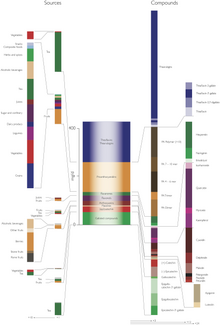
The main type of flavonoids consumed in the EU and USA were flavan-3-ols, mainly from tea, while intake of other flavonoids was considerably lower.
Research
Though there is ongoing research into the potential health benefits of individual flavonoids, neither the Food and Drug Administration (FDA) nor the European Food Safety Authority (EFSA) has approved any health claim for flavonoids or approved any flavonoids as pharmaceutical drugs. Moreover, several companies have been cautioned by the FDA over misleading health claims.
In vitro
Flavonoids have been shown to have a wide range of biological and pharmacological activities in in vitro studies. Examples include anti-allergic,anti-inflammatory,antioxidant,anti-microbial (antibacterial,antifungal, and antiviral), anti-cancer, and anti-diarrheal activities. Flavonoids have also been shown to inhibit topoisomerase enzymes and to induce DNA mutations in the mixed-lineage leukemia (MLL) gene in in vitro studies. However, in most of the above cases no follow up in vivo or clinical research has been performed, leaving it impossible to say if these activities have any beneficial or detrimental effect on human health. Biological and pharmacological activities which have been investigated in greater depth are described below.
Antioxidant
Research at the Linus Pauling Institute and the European Food Safety Authority shows that flavonoids are poorly absorbed in the human body (less than 5%), with most of what is absorbed being quickly metabolized and excreted. These findings suggest that flavonoids have negligible systemic antioxidant activity, and that the increase in antioxidant capacity of blood seen after consumption of flavonoid-rich foods is not caused directly by flavonoids, but is due to production of uric acid resulting from flavonoid depolymerization và excretion.
Inflammation
Inflammation has been implicated as a possible origin of numerous local and systemic diseases, such as cancer,cardiovascular disorders,diabetes mellitus, and celiac disease.
Preliminary studies indicate that flavonoids may affect anti-inflammatory mechanisms via their ability to inhibit reactive oxygen hoặc nitrogen compounds. Flavonoids have also been proposed to inhibit the pro-inflammatory activity of enzymes involved in free radical production, such as cyclooxygenase, lipoxygenase hoặc inducible nitric oxide synthase, and to modify intracellular signaling pathways in immune cells, or in brain cells after a stroke.
Procyanidins, a class of flavonoids, have been shown in preliminary research to have anti-inflammatory mechanisms including modulation of the arachidonic acid pathway, inhibition of gene transcription, expression and activity of inflammatory enzymes, as well as secretion of anti-inflammatory mediators.
Cancer
Clinical studies investigating the relationship between flavonoid consumption and cancer prevention/development are conflicting for most types of cancer, probably because most studies are retrospective in design and use a small sample size. Two apparent exceptions are gastric carcinoma và smoking-related cancers. Dietary flavonoid intake is associated with reduced gastric carcinoma risk in women, and reduced aerodigestive tract cancer risk in smokers.
Cardiovascular diseases
Among the most intensively studied of general human disorders possibly affected by dietary flavonoids, preliminary cardiovascular disease research has revealed the following mechanisms under investigation in patients or normal subjects:
- inhibit coagulation, thrombus formation or platelet aggregation
- reduce risk of atherosclerosis
- reduce arterial blood pressure and risk of hypertension
- reduce oxidative stress and related signaling pathways in blood vessel cells
- modify vascular inflammatory mechanisms
- improve endothelial và capillary function
- modify blood lipid levels
- regulate carbohydrate và glucose metabolism
- modify mechanisms of aging
Listed on the clinical trial registry of the US National Institutes of Health (July 2016) are 48 human studies completed or underway to study the dietary effects of plant flavonoids on cardiovascular diseases.
However, population-based studies have failed to show a strong beneficial effect which might be due to the considerably lower intake in the habitual diet of those investigated.
Antibacterial
Flavonoids have been shown to have (a) direct antibacterial activity, (b) synergistic activity with antibiotics, and (c) the ability to suppress bacterial virulence factors in numerous in vitro and a limited number of in vivo studies. Noteworthy among the in vivo studies is the finding that oral quercetin protects guinea pigs against the Group 1 carcinogen Helicobacter pylori. Researchers from the European Prospective Investigation into Cancer and Nutrition have speculated this may be one reason why dietary flavonoid intake is associated with reduced gastric carcinoma risk in European women. Additional in vivo and clinical research is needed to determine if flavonoids could be used as pharmaceutical drugs for the treatment of bacterial infection, or whether dietary flavonoid intake offers any protection against infection.
Synthesis, detection, quantification, and semi-synthetic alterations
Color Spectrum
Flavonoid synthesis in plants is induced by light color spectrums at both high and low energy radiations. Low energy radiations are accepted by phytochrome, while high energy radiations are accepted by carotenoids, flavins, cryptochromes in addition to phytochromes. The photomorphogenic process of phytochome-mediated flavonoid biosynthesis has been observed in Amaranthus, barley, maize, Sorghum and turnip. Red light promotes flavonoid synthesis.
Availability through microorganisms
Several recent research articles have demonstrated the efficient production of flavonoid molecules from genetically engineered microorganisms.
Tests for detection
- Shinoda test
Four pieces of magnesium fillings are added to the ethanolic extract followed by few drops of concentrated hydrochloric acid. A pink or red colour indicates the presence of flavonoid. Colours varying from orange to red indicated flavones, red to crimson indicated flavonoids, crimson to magenta indicated flavonones.
- Sodium hydroxide test
About 5 mg of the compound is dissolved in water, warmed and filtered. 10% aqueous natri hydroxide is added to 2 ml of this solution. This produces a yellow coloration. A change in color from yellow to colorless on addition of dilute hydrochloric acid is an indication for the presence of flavonoids.
- p-Dimethylaminocinnamaldehyde test
A colorimetric assay based upon the reaction of A-rings with the chromogen p-dimethylaminocinnamaldehyde (DMACA) has been developed for flavanoids in beer that can be compared with the vanillin procedure.
Quantification
Lamaison and Carnet have designed a test for the determination of the total flavonoid content of a sample (AlCI3 method). After proper mixing of the sample and the reagent, the mixture is incubated for 10 minutes at ambient temperature and the absorbance of the solution is read at 440 nm. Flavonoid content is expressed in mg/g of quercetin.
Semi-synthetic alterations
Immobilized Candida antarctica lipase can be used to catalyze the regioselective acylation of flavonoids.
Xem thêm
Đọc thêm
- Andersen, Ø.M. / Markham, K.R. (2006). Flavonoids: Chemistry, Biochemistry and Applications. CRC Press. ISBN 978-0-8493-2021-7
- Grotewold, Erich (2007). The Science of Flavonoids. Springer. ISBN 978-0-387-74550-3
- Comparative Biochemistry of the Flavonoids, by J.B. Harborne, 1967 (Google Books)
- The systematic identification of flavonoids, by T.J. Mabry, K.R. Markham and M.B. Thomas, 1970, doi:10.1016/0022-2860(71)87109-0
Các liên kết ngoài
- Flavonoids (chemistry) Lưu trữ 2005-02-04 tại Wayback Machine
- Micronutrient Information Center – Flavonoids
- Flavonoid Composition of Fruit Tissues of Citrus Species Lưu trữ 2007-05-28 tại Wayback Machine
Các dữ liệu
- FlavonoidViewer.jp Lưu trữ 2013-05-30 tại Wayback Machine (Japanese, English), a database on flavonoids by Arita Group (Univ of Tokyo, RIKEN Plant Science Center, and Keio Univ), Nishioka Group (Kyoto and Keio Univ) and Kanaya Group (NAIST)
- USDA Database of Flavonoid content of food Lưu trữ 2012-07-16 tại Wayback Machine (pdf)
|
Các loại polyphenol
| |
|---|---|
| Phân loại | |
| Xem thêm: | |
| Antihemorrhoidals để sử dụng tại chỗ | |
|---|---|
| Antivaricose điều trị |
heparins hoặc heparinoids để sử dụng tại chỗ (Organo-heparinoid, Sodium apolate, Heparin, Pentosan polysulfate)
Các chất sclerosing cho tiêm chủng địa phương (sclerosing agents for local injection) (Monoethanolamine oleate, Polidocanol, Invert sugar, Sodium tetradecyl sulfate, Phenol) other (Calcium dobesilate) |
| Các tác nhân mao dẫn ổn định |
bioflavonoids (Rutoside, Monoxerutin, Diosmin, Troxerutin, Hidrosmin) - other (Tribenoside, Etamsylate) |
|
Các loại phenylpropanoid
| |
|---|---|
| Các nhánh của phenylpropanoid | |
| Ví dụ | |
|
Các loại flavonoids
| |
|---|---|
| Flavonoids | |
| Isoflavonoids | |
| Neoflavonoids | |
| Aurones | |
| Other categories | |